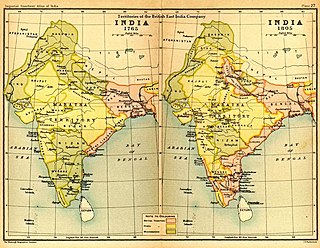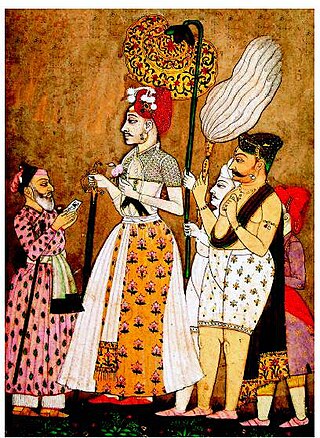
The Third Battle of Panipat took place on 14 January 1761 between the Maratha Empire and the invading army of the Durrani Empire. The battle took place in and around the city of Panipat, approximately 97 kilometres (60 mi) north of Delhi. The Afghans were supported by four key allies in India: the Pashtun Rohillas under the command of Najib ad-Dawlah, the Baloch Khanate of Kalat, and the Oudh State under Shuja-ud-Daula as well as elements of the declining Mughal Empire. The Maratha army was led by Sadashivrao Bhau, who was third-highest authority of the Maratha Empire after the Chhatrapati and the Peshwa. The bulk of the Maratha army was stationed in the Deccan Plateau with the Peshwa.

The Maratha Empire, also referred to as the Maratha Confederacy, was an early modern Indian confederation that rose to dominate much of the Indian subcontinent in the 18th century. Maratha rule formally began in 1674 with the coronation of Shivaji of the Bhonsle Dynasty as the Chhatrapati. Although Shivaji came from the Maratha caste, the Maratha empire also included warriors, administrators and other notables from Maratha and several other castes from Maharashtra.
The Peshwa was the appointed prime minister of the Maratha Empire of the Indian subcontinent. Originally, the Peshwas served as subordinates to the Chhatrapati ; later, under the Bhat family, they became the de facto leaders of the Maratha Confederacy, with the Chhatrapati becoming a nominal ruler. During the last years of the Maratha Empire, the Peshwas themselves were reduced to titular leaders, and remained under the authority of the Maratha nobles and the British East India Company.

Balaji Bajirao, also known as Nana Saheb I, was the 8th Peshwa of the Maratha Confederacy in India. He was appointed as Peshwa in 1740 upon the death of his illustrious father, the Peshwa Bajirao I.

Gaekwads, a Hindu Maratha dynasty of the former Maratha Empire and its subsequent (erstwhile) princely state of Baroda in western India from the early 18th century until 1947. The ruling prince was known as the Maharaja Gaekwad of Baroda. With the city of Baroda (Vadodara) as its capital, during the British Raj its relations with the British were managed by the Baroda Residency. It was one of the largest and wealthiest princely states existing alongside British India, with wealth coming from the lucrative cotton business as well as rice, wheat and sugar production.

Malhar Rao Holkar was a noble subedar of the Maratha Empire, in present-day India. He was one of the early officers along with Ranoji Scindia to help spread the Maratha rule to northern states and was given the estate of Indore to rule by the Peshwas, during the reign of the Maratha emperor Shahu I. He was founder of the Holkar dynasty that ruled Malwa.

The Maratha Conquests were a series of conquests in the Indian subcontinent which led to the building of the Maratha Empire. These conquests were started by Shivaji in 1659, from the victory at the Battle of Pratapgad against Bijapur. The expansion of the empire was limited and interrupted by the Mughal conquests of south India by Mughal emperor Aurangzeb. Marathas were forced to defend their territories against the overwhelmingly strong Mughal army in the 27 years long Deccan wars. They were able to defend their territories and gain an upper hand over Mughals in the sustained conflict.

Bhushangad is a hill fort in the Khatav taluk of the Satara district of Maharashtra, India. It is oval in shape, and rises 600 feet (180 m) above the surrounding plain. Its top is flat, and measures to be about 300 square yards (250 m2) in area.

Sadashivrao Bhau Peshwa was son of Chimaji Appa and Rakhmabai and the nephew of Baji Rao I. He was a finance minister during the reign of Maratha emperor Chhatrapati Rajaram II. He led the Maratha army at the Third Battle of Panipat.

Gharge-Desai (Deshmukh) were the rulers of one of the oldest Maratha princely states of Nimsod in Satara District.

Narnala Fort or Narnala Qila Sarkar, also known as Shahnoor Fort, is a hill fortress in the Satpura Range of Vidarbh, Maharashtra, India, named after the Rajput Solanki Chalukya Ruler, Raja Narnal Singh, also known as Narnal Singh Swami. It was renamed as "Shahnoor" by Islamic rulers but again acquired, rebuilt and got its name "Narnala" by ruler Rao Rana Narnal Singh Solanki, who migrated from Patan in Gujarat.
Attock Fort was built at Attock Khurd during the reign of Akbar from 1581 to 1583 under the supervision of Khawaja Shamsuddin Khawafi to protect the passage of the River Indus. Attock was briefly captured on 28 April 1758 by the Maratha Empire and became the northern boundary of the Maratha Empire. Ahmad Shah Durrani recaptured Attock and halted the Maratha advance in the north permanently after the Third Battle of Panipat. It featured a prominent role in Afghan-Sikh Wars during the Battle of Attock.
Bhoite is a surname found amongst the Maratha caste, mainly in the state of Maharashtra in India but it also appears in Indian states bordering Maharashtra.
Harpale (हरपळे) is a surname used by a subclan of Maratha. The name is legendary among Maratha Royalties. They were honoured as Sardar, Patil, Deshmukh, etc. The Maratha Community come mostly from Maharashtra and neighbouring states. Harphales capital is Phursungi town near Pune. They have a Royal Mark of Gaikwad Maharajas of Baroda. They possess Deshmukh rights of villages in Nagpur. Their relations are associated with the prominent Maratha clan of 96 Royal Clans.
Pisal is surname mainly found amongst the 96 Maratha clans.

Bhor State was one of the 9-gun salute Maratha princely states of British India. It was the only state belonging to the Poona Agency under the Bombay Presidency, which became later part of the Deccan States Agency. Along with Akkalkot State, Aundh State, Phaltan State, Nimsod State and Jath State, it was one of the Satara Jagirs. The state merged with the newly independent Indian union in 1948.
The Maratha conquest of Northwest India occurred between 1757 and 1759, when the Maratha Empire captured the northwestern parts of the Indian subcontinent from the Durrani Empire. It had long-lasting effects upon the future geopolitics of the Indian subcontinent.

The following list includes a brief about the titles of nobility or orders of chivalry used by the Marathas of India and by the Marathis/Konkanis in general.
The Bhat Peshwa family earlier known as Bhat family is a prominent Indian Chitpavan Brahmin family who dominated India for around 100 years in the late 18th century and early 19th century. Most of the members in this family were the Peshwas in the Peshwa Era of the Maratha Empire, and Peshwa later became their family name. During their regime, most of the Indian subcontinent was under their control. The last Peshwa, Baji Rao II, was defeated by the British East India Company in the Third Anglo-Maratha War in 1818. The territory was annexed to the British East India Company's Bombay Presidency, and he was pensioned
Mhaswad was a Jagir during the Maratha Empire and later become part of Deccan States Agency of the British Raj. It was governed by Mane who were Feudatories of Nimsod State. Mhaswad is situated on bank of Manganga river, Historically Mann region was once ruled by Chalukya dynasty of Badami. In 11th century Chalukya rulers build this temple as it was considered to be their ancestors god, latter in 1738 another Jagirdar family under Nimsod State named as Dubal built half of the temple,













